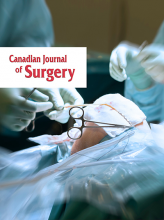I read with interest the editorial entitled “Dissatisfaction: how it has grown” (Can J Surg 2005;48:93–4). I believe that the points made are valid. There are additional factors affecting the surgical workforce and its future planning. With much of our human resource planning we have taken into account only the increasing age of the population and the decreasing number of physicians. We must also be cognizant of the fact that technologic advances open health care options to those who previously were not candidates for treatment. Additionally, the delivery of health care by some of the younger members of the profession may not be as broad-based and their practices not as all-encompassing as those whom they are replacing. Many of the retiring physicians have had broad training, and our training programs are not creating true replacements. Fiscally based cutbacks in hospitals have many of us finding it increasingly difficult to provide the care we are trained to administer to the patients who need our services. It now seems that more work is required to deliver the same necessary care. The beleaguered and burned-out surgeon may be less willing to postpone retirement as institutional loyalty has diminished over the years. This may accelerate the human resource crisis looming on the horizon.
Although no one would dispute the need for the increased number of family doctors, political pressures should not lead to a worsening of the situation by increased emphasis on family medicine at the expense of specialist training. Training positions for specialists must increase at the same time as they increase for family medicine.
Regionalization may be a solution to the issue of superspecialization. There is certainly a need for those highly trained and focused specialists, but we must emphasize throughout our training a need for broadly trained, generally based physicians who are competent to deliver care in areas other than the most highly specialized centres.
Human resource issues must be addressed at both the provincial and the federal levels to generate a plan to provide care for future generations. Simple number crunching will not successfully address the issue, as it does not account for advances in medicine or changing attitudes, values and training. The point made regarding the involvement of surgical experts to give best considered opinion regarding human resource planning is well taken.
As a profession, I believe that we must move away from service provision needs for residency rotation assignment. Servicing of teaching hospitals should not be allowed to control rotations. We must focus more on the skills that our trainees need when they complete training. Much broader based training should be provided, and the subspecialization should occur in the post-fellowship years. Perhaps our training models are not ideal in that the teaching and role modelling is done by a group of superspecialists. I believe that national specialty societies and Royal College specialty committees must seriously address the issue of what is needed in a training program to produce the surgeons to deliver health care to Canadians in the future. This will be a difficult task, as the committees are largely populated by subspecialists, but we will need to put our bias aside and address this issue in a socially responsible fashion.






